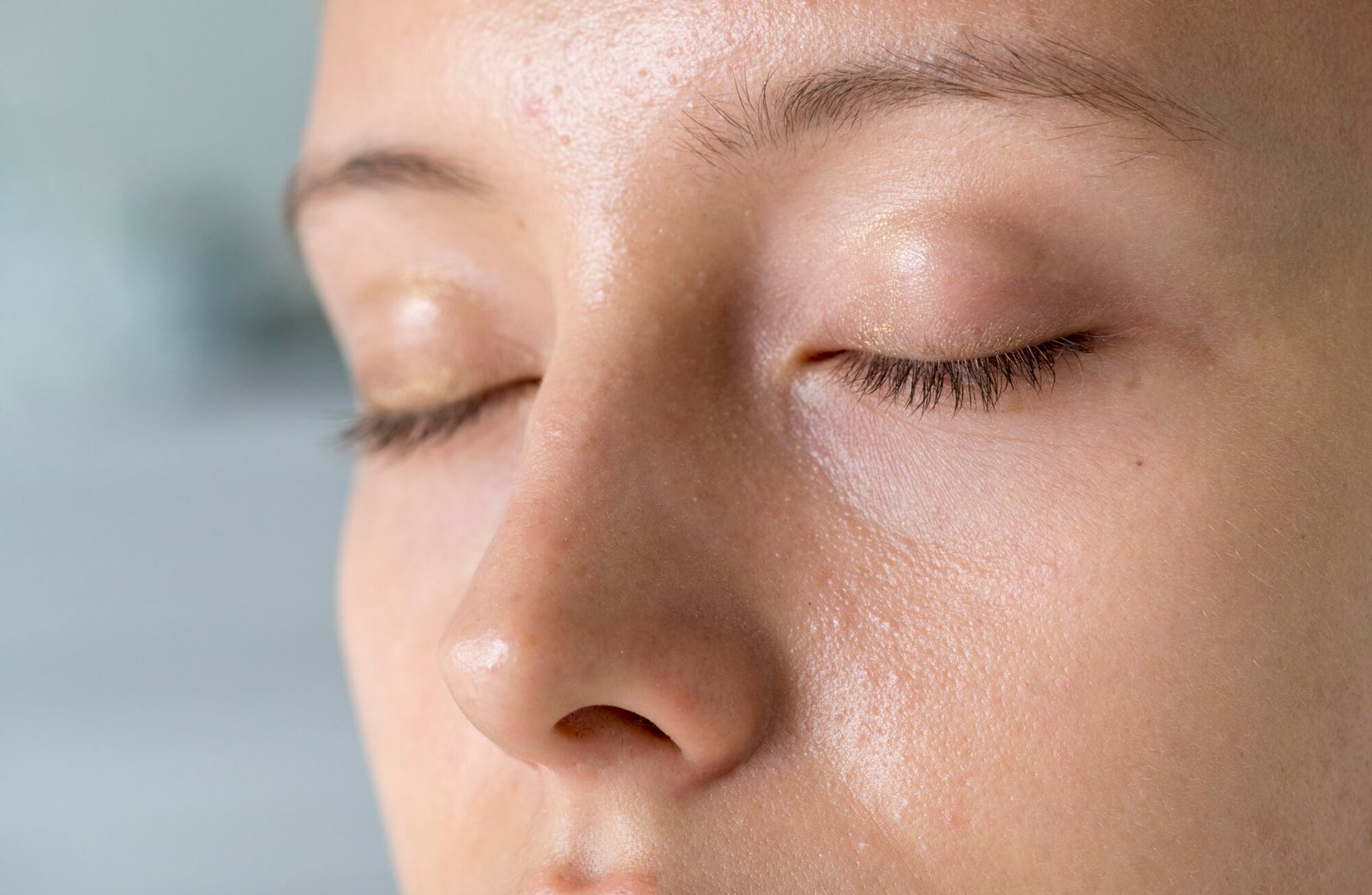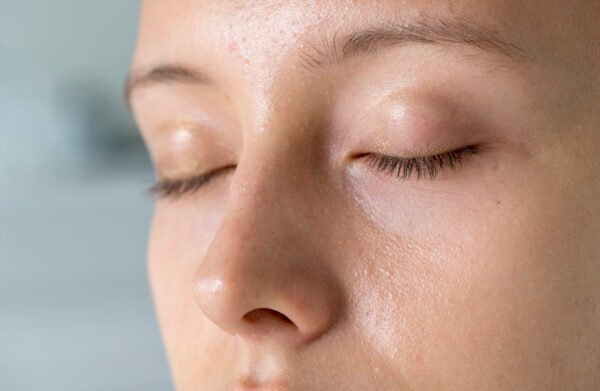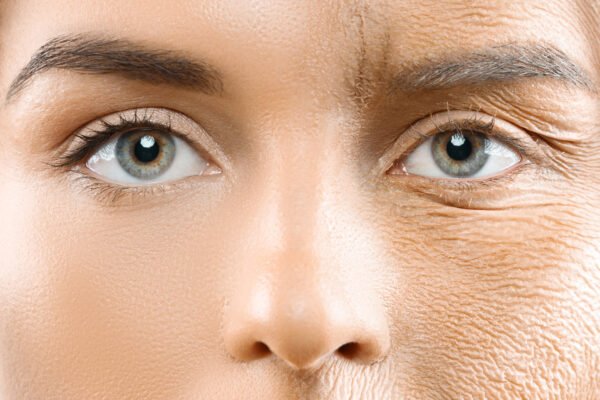Introduction
The Basics of Oily Skin
Why does your face shine more in the mirror? Oily skin may cause issues. Sebaceous glands cause oily skin. Sebum protects and nourishes skin, but too much may create shine and other matters.
A healthy skincare routine requires knowing your skin type. Shine, acne, and pores increase with oily skin. Good news—oily skin ages nicely and wrinkles less. Learn these traits to regulate oily skin.
It is going beyond oily skin gloss. Knowing the best oily skin products is vital. Understand its intricacy to overcome challenges and maintain a healthy glow without shine.
Why Oily Skin Has Larger Pores?
Larger pores characterize oily skin. Pores discharge sebum onto the skin, appearing more extensive due to sebum stretching. That makes oily skin pores seem wider than dry skin pores.
Several factors induce enlarged pores. Pore size is hereditary; hence, genes matter. Puberty and pregnancy increase sebum, enlarging pores. Poor skincare practices like over-exfoliating or harsh products may aggravate pores.
To fix this, use skincare products that constrict pores. Niacinamide and salicylic acid reduce oil and refine pores. Exfoliating and moisturizing frequently may decrease pores.
The Unwanted Glow Managing Excess Shine
Permanent shine is one of the worst elements of oily skin. T-zone shines on the forehead, nose, and chin since they have more sebaceous glands than other facial locations.
Mattifying products and oil management must be modified to reduce shine without drying skin. A mild, oil-free cleanser removes excess oil without drying, and an astringent witch hazel or tea tree oil toner controls oil.
Bring blotting papers or mattifying powders for daylong shine control. These fast treatments absorb oil without damaging makeup or skincare, leaving skin fresh and less greasy.
Why Oily Skin Is Prone to Breakouts?
Breakouts are a significant issue for oily skin. Acne may result from excess sebum and dead skin cells clogging pores. Thus, oily skin suffers from blackheads, whiteheads, and severe acne.
Hormonal changes can worsen breakouts due to increased sebum production. Nutrition and stress may also cause sebaceous glands to overwork. Acne management for those with oily skin requires understanding these causes.
To treat acne, choose products containing benzoyl peroxide and salicylic acid. These substances remove congestion and decrease inflammation through the pores. Preventing and treating breakouts requires consistency in skincare.
Best Practices for Oily Skin Care
Following the appropriate skincare routines may help manage oily skin, which can be difficult. To eliminate oil and pollutants without drying, use an oily skin cleanser. Avoid alcohol-based products, which peel the skin and increase oil production.
Even oily skin needs moisture. A lightweight, oil-free moisturizer will nourish skin without adding oil. Find hyaluronic acid, which hydrates without becoming oily.
Finally, shield yourself from the sun. A gel-based, non-comedogenic sunscreen protects oily skin from UV damage without adding shine.
The Role of Diet in Oily Skin Management
Your diet might shockingly affect your skin’s oil production. While no one meal causes oily skin, several diets might affect skin oil production. Sugary and refined carbohydrate diets raise insulin levels and sebum production.
Omega-3-rich meals like salmon and walnuts may balance oil production. Healthy fats reduce inflammation and improve skin health. Consuming enough water might also help maintain skin equilibrium.
Monitoring your diet and making healthy modifications will help your skincare regimen control oily skin and decrease shine and breakouts.
Product Picks for Oily Skin Care
Managing oily skin requires the correct products. Look for cleansers with salicylic acid to exfoliate and clarify pores. Neutrogena Oil-Free Acne Wash addresses oil and acne.
Choose lightweight, oil-free moisturizers like La Roche-Posay Effaclar Mat, which mattifies skin. For effectiveness, try Thayers Alcohol-Free Witch Hazel Toner. It controls oil without drying using natural components.
Finally, a weekly clay mask like Aztec Secret Indian Healing Clay removes impurities and excess oil, refreshing and balancing the skin.
Lifestyle Adjustments for Better Skin
Minor lifestyle modifications may help manage oily skin. Washing pillows and towels regularly prevents oils and germs from reaching your skin. Avoid touching your face all day to prevent dirt and oils from spreading.
Maintaining a daily skincare regimen is essential for good skin. Sleeping adequately and controlling stress may also boost skin oil production.
These small changes and a customized skincare routine may help you control oily skin for a brighter, healthier complexion.
The Benefits of Oily Skin
Managing oily skin is difficult, but it has benefits. One benefit is that oily skin looks younger and longer. Natural oils moisturize and fill the skin, eliminating fine lines and wrinkles.
Oily skin is also more resistant to wind and pollutants, which may dry and irritate delicate skin. With resiliency, dryness and flakiness may decrease.
Understanding and appreciating these advantages may boost your confidence in your skin type and motivate you to care for it.
Busting Myths About Oily Skin
Many myths about oily skin require refuting. One frequent fallacy is that oily skin doesn’t need moisturizer. A missing moisturizer might increase oil production as the skin attempts to compensate.
Another fallacy is that regular exfoliation reduces oiliness. When over-exfoliated, the skin produces more sebum because it loses vital oils. Gentle exfoliation twice a week is excellent.
Sunscreen is necessary for all skin types, even oily skin. Avoid shine by using an oily skin sunscreen.
Building a Routine That Works for You
Managing oily skin requires a customized skincare program. Use a mild cleanser and toner to eliminate pollutants. Acne and enlarged pores need specific therapy.
For balanced skin, use a lightweight moisturizer after therapy goods are absorbed. Finally, use a mattifying sunscreen to prevent daytime UV damage.
Experimenting with products and techniques can help you discover the proper regimen for regulating oily skin and enhancing its attractiveness.
The Importance of Consistency in Skincare
Sticking to regular skin care practices is essential for controlling oily skin. Using your chosen items regularly will help control oil production and make breakouts less likely.
Understanding Your Skin Type
To care for your skin correctly, you must know the difference between oily skin and other skin types. People with oily skin produce too much sebum, which makes their skin look shiny and causes their pores to enlarge.
Seasonal Considerations for Oily Skin
Different seasons can make oily skin react in various ways. For example, when it’s hot and muggy, your body may produce more oil, but when it’s cold, you may need to change your routine to avoid dehydrating.
Professional Treatments for Oily Skin
Over-the-counter medicines might not always be enough. Speaking to a dermatologist can help you get professional treatments like chemical peels or prescription drugs specially made for your face.
Conclusion:
To have a balanced complexion, you must understand oily skin. By identifying these qualities, you may personalize your skincare regimen to issues like excess shine, enlarged pores, and acne.
Use products and methods that regulate oil production without drying your skin. With the appropriate strategy, you can control oily skin for a healthy, glowing complexion.
Consult a dermatologist or skincare specialist for specific advice. Learn how to optimize your oily skin with the correct tools.







